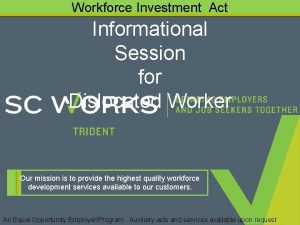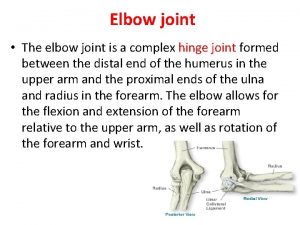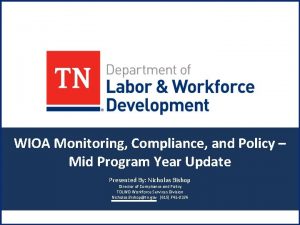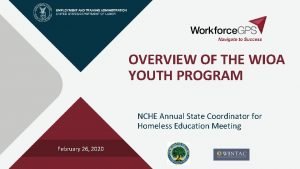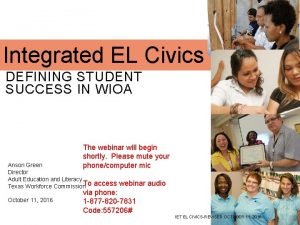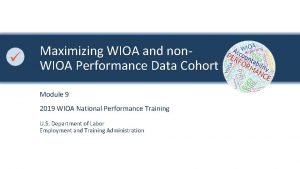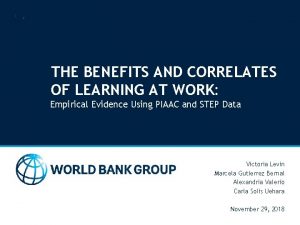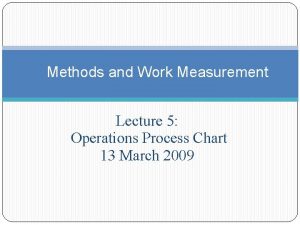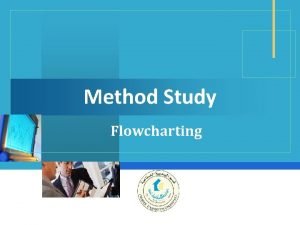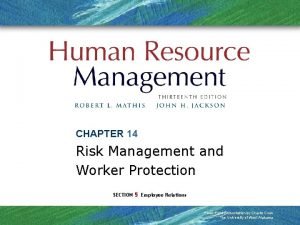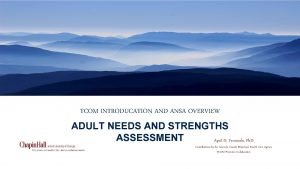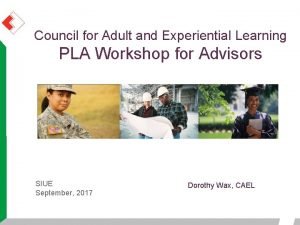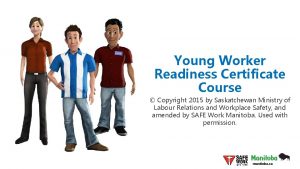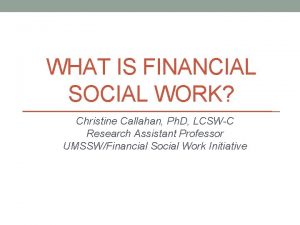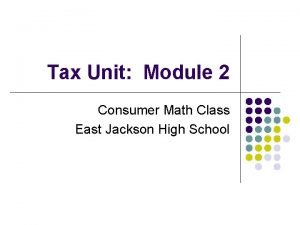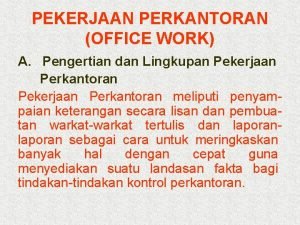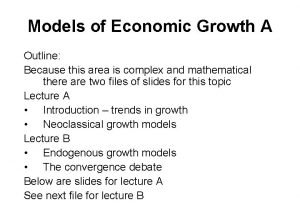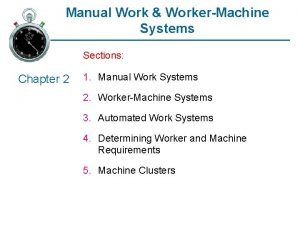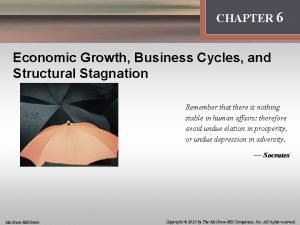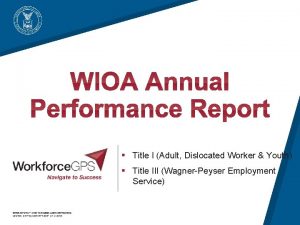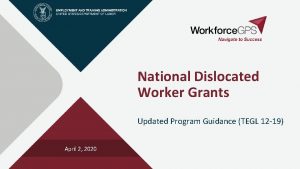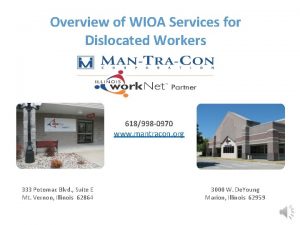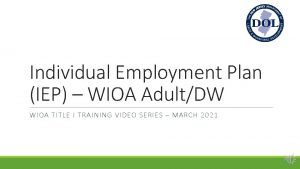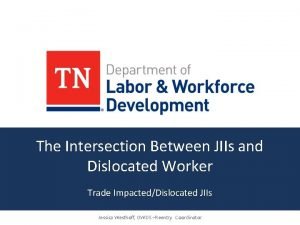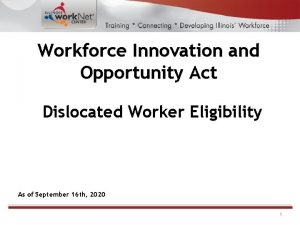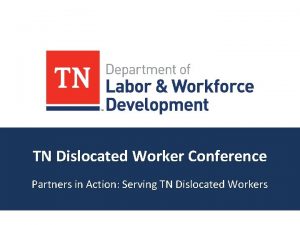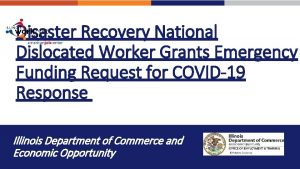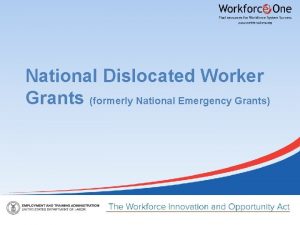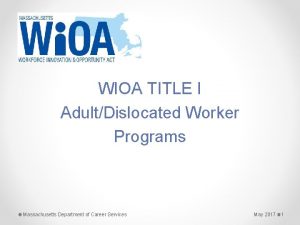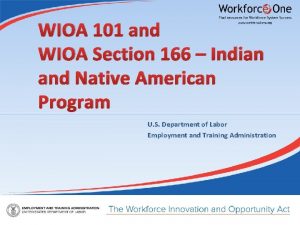WIOA Title I Adult and Dislocated Worker Program






































- Slides: 38

WIOA Title I Adult and Dislocated Worker Program October 14, 2020

Today’s webinar will be recorded. • Please use the chat box to introduce yourself. • You can listen through speakers or use the dial-in option listed with the webinar link. • You can use the chat box or “raise hand” feature to ask a question. • Please remember to mute your computers and phones to minimize background noise. 2

TOPICS Importance of WIOA Eligibility Criteria for Adults and Dislocated Workers Source Documentation Career Services/ Training Career Planning Coordination with WIOA Partner Programs Shared Customers 3

Importance of the Workforce Innovation and Opportunity Act • WIOA focuses on serving individuals with barriers to employment and seeks to ensure these individuals receive access to quality of services. • Services provided to eligible individuals under the WIOA Title I Adult and Dislocated Worker Program lead to pathways for economic selfsufficiency. 4

WIOA Adult Eligibility/Priority of Service • Citizenship or work authorized, AND Selective Service Compliance AND 18 or older • Populations Given Priority of Service for Individualized and Training Services o Covered persons (Veterans and eligible spouses) o Public assistance o Other low income o Basic skills deficient The Local Board and the Governor may establish a process that also gives priority to other individuals eligible to receive such services, provided that it is consistent with priority of service for Veterans. (§ 680. 600(c)) * *VETERANS PRIORITY OF SERVICE - Mass Workforce issuance 100 DCS 15. 100 o Veterans under WIOA sec. 3(63)(A) and 38 U. S. C. 101 receive priority of service in all Department of Laborfunded training programs under 38 U. S. C. 4215 and described in 20 CFR 1010. A Veteran must still meet each program’s eligibility criteria to receive services under the respective employment and training program. 5

WIOA Adult Eligibility/Priority of Service Priority Ordering (for individualized and training services) I. First, to veterans and eligible spouses who are also included in the groups given statutory priority for WIOA adult formula funds. II. Second, to non-covered persons (that is, individuals who are not veterans or eligible spouses) who are included in the groups given priority for WIOA adult formula funds. III. Third, to veterans and eligible spouses who are not included in WIOA’s priority groups. IV. Fourth, priority populations established by the Local Workforce Development Board V. Last, to non-covered persons outside the groups given priority under WIOA 6

WIOA Dislocated Worker Eligibility • Citizenship or work authorized, and Selective Service Compliance • One or more of the following four (4) conditions: 1. Employment Status of Received Notice of Layoff OR Layoff Status of Terminated/Laid Off AND UI Claimant (Active/Expired/Exhausted) OR Workforce Attachment = “Yes” AND is unlikely to return to a previous industry or occupation 2. Employment Status of Received Notice of Layoff OR Layoff Status of Terminated/Laid Off AND Work History record with a Layoff ID 3. Displaced Homemaker 4. Layoff Status of Unemployed, Previously Self Employed 7

WIOA Dislocated Worker Eligibility Definitions DISPLACED HOMEMAKER (WIOA sec. 3(16)) – an individual who has been providing unpaid services to family members in the home and who – • (A) (i) has been depending on the income of another family member but is no longer supported by • • that income; or (ii) is the dependent spouse of a member of the Armed Forced on active duty and whose family income is significantly reduced because of a deployment, or call to active duty, or service connected death or disability, AND (B) Is unemployed or underemployed and is experiencing difficulty in obtaining or upgrading employment ATTACHMENT TO THE WORKFORCE (WIOA sec. 3(15)) - an individual who has been employed for a duration sufficient to demonstrate, to the appropriate entity at a one-stop center referred to in section 121(e), attachment to the workforce, but is not eligible for unemployment compensation due to insufficient earnings or having performed services for an employer that were not covered under a State unemployment compensation law… 8

WIOA Dislocated Worker Eligibility Employment Status 9

WIOA Dislocated Worker Eligibility UI Claimant Status, Layoff Status, Workforce Attachment 10

WIOA Dislocated Worker Eligibility Displaced Homemaker 11

Income Stuff • Self Attestation Question on Full Tab 12

Income Stuff • Verifying Income 13

Source Documentation • Documentation is necessary to support Adult and Dislocated Worker eligibility and priority of service. • Staff must verify and confirm that individuals are eligible to participate in Adult and Dislocated Worker program services through an examination of documents. • Documentation may be stored electronically, however documentation must be available to program monitors, fiscal monitors, and auditors. (Security protocols to safeguard personal information must be in place. ) • Local areas must retain records for a period of at least three (3) years after the submittal of the final closeout expenditure report for that funding period. v 100 DCS 18. 101. 4 Eligibility Requirements for WIOA Title I Adult and Dislocated Worker 13

Three Types of Career Services **UNDER WIOA THERE IS NO LONGER A SEQUENCE SERVICES** OF • Basic Career Services: Universally accessible and made available to all individuals seeking employment and training. – Services include: • Eligibility Determination • Initial Skills Assessment • Labor Exchange Services • Information on Programs and Services • Program Referrals v Basic services must be made available in at least one comprehensive Career Center per local area. • Basic Career Services may be provided by Adult and Dislocated Worker staff and Employment Services staff. 15

Three Types of Career Services continued… • Individualized Career Services: Made available to participants after staff determine that such services are required to retain or obtain employment consistent with applicable statutory priorities. – Services Include: • Specialized Assessment • Development of Individualized Employment Plan Ø Jointly developed by the participant and career planner ü On-going strategy to identify: ü Employment goals ü Achievement objectives ü Appropriate combination of services for the participant to achieve the employment goals • Counseling • Work Experiences (including transitional jobs) Ø Transitional Jobs: time limited and wage-paid work experiences up to 100 percent subsidized. ü Must be combined with career and supportive services ü Established work history, demonstrates success in the workplace and develops skills ü Local Boards may use 10% of funds to support transitional jobs Individualized Career Services may be provided by Adult and Dislocated Worker staff and Employment Services staff. 16

Training Services • Training may be provided whether or not the individual has received basic or individualized career services first. • Exception – When career services are not provided before training, career center staff and partner program staff must adhere to the Local Board’s policy that provides justification of the circumstances in which to provide services without first providing career services. v Case file must contain a determination of the need for training services. – Training can be justified through the use an interview, evaluation, assessment, or career planning. • The following tools can be used to justify training (the list below is not intended to be limiting): – Work Keys Placement Quiz or Exam – Mass. CIS – TORQ – Academic Assessment Tool • Staff must adhere to the local area policy on eligibility for training 17

Training Services continued… • Individual Training Account (ITA) – Training provided by an Eligible Training Provider (ETP) – Participants must have access to the Eligible Training Provider List (ETPL) * The ETPL is accessible to all local OSCCs and customers through Job Quest v Types of Training Services that may be provided Include but are not limited to: – Occupational Skills Training – OJT Training – Incumbent Worker Training – Workplace training with related instruction – Training programs operated by the private sector – Skill upgrade and training – Entrepreneurial Skills Training – Job readiness training – Adult education and literacy activities – Customized Training 18

Training Services continued… • Under certain circumstances a training contract may be used to provide training. This type of training is referred to as a “training exception” or “contract exception” • One of five circumstance need to apply and the process for using a contract exception must be described in the local plan: – OJT – Insufficient Number of ETPs – Training Program that has Demonstrated Effectiveness – Training Provided by an Institution of Higher Education – Pay for Performance Contracts The Local Board must fulfil the consumer choice requirements in 20 CFR 680. 340 v Local WDBs may determine that providing training through a combination of ITAs and contracts is the most effective approach to placing participants in programs such as Registered Apprenticeship programs and other similar types of training. 19

Three Types of Career Services continued…… • Follow-Up Services: Provided for 12 months after the first day participants are placed in unsubsidized employment. Local area policies must define appropriate follow-up services. – Services Include: • Providing individuals counseling about the workplace • Career planning and counseling • Information about additional educational opportunities • Referral to support services available in the community and peer support groups • Case management administrative follow-up Follow up services for case planning are not to be construed as follow up services required for performance reporting. v 100 DCS 08. 102: WIOA Title I Follow Up Services Policy: http: //www. mass. gov/massworkforce/docs/issuances/wioa-policy/08 -102. pdf 20

Assessments Local Board identifies the assessments used to determine eligibility for individualized and training services. Examples of assessment include but are not limited to: • Recent (within 6 months) pervious interviews or evaluations • Assessment by partner programs Case file must contain a determination of the need for training services. – Training can be justified through the use an interview, evaluation, assessment, or career planning. • The following tools can be used to justify training (the list below is not intended to be limiting): – Work Keys Placement Quiz or Exam – Mass. CIS – TORQ – Academic Assessment Tool 21

Tracking Follow-Up Services in MOSES • Follow-up variants for tracking; – Required 12 Month Follow-up • Overarching, required by law – After Exit Follow-up Services • Specific services delivered after exit (e. g. Counseling) – Retention Services • Extremely Important for federal performance – Employment Follow-up Services • Possibly extremely important for federal performance 22

Types of Follow Up Services Entry Required 12 Month Follow Up 23

Types of Follow Up Services Entry After Exit Follow Up Services (Use the After Exit Follow-up service detail so that a new participation cycle is not created) 24

Types of Follow Up Services Entry Retention Services (Month 1 – 12) 25

Types of Follow Up Services Entry Employment Follow Up Services 26

Supportive Services and Needs Related Payments Supportive Services • Available to Adults and Dislocated Workers participating in Title I career services or training activities. • Enables the individual to participate in career services or training activities. Needs Related Payments • Designed to provide participants with financial assistance to participate in training services • Participants must be enrolled in a training program in order to receive needs-related payments v 100 DCS 08. 106: Supportive Services and Needs-Related Payments for Title I Adults and Dislocated Worker Youth Policy http: //www. mass. gov/massworkforce/docs/issuances/wioa-policy/08 -106. pdf 27

Career Planning Requirements • All customers enrolled in WIOA Title I Adult and DW program receiving individualized career services will have an Individualized Employment Plan also known as the Career Action Plan (CAP). • The CAP is an individualized career service consisting of connected activities, jointly developed by the participant and career center staff. • The CAP is an ongoing strategy used to identify: – Employment Goals – Achievement Objectives – Appropriate Combination of Services • The CAP must be monitored by staff to ensure effectiveness. • Career Planning must be documented in the Career Plan in MOSES Mass. Workforce Issuance 100 DCS 08. 112. 10: Career Planning for Workforce Innovation and Opportunity Act (WIOA) Job Seeker Customers 28

Career Plan in MOSES 29

Career Plan in MOSES 30

Career Plan in MOSES 31

EFFECTIVE CASE MANAGEMENT 32

Coordination with WIOA Partner Programs PARTNER PROGRAM POPULATION SERVICES WIOA Title I Youth Program (Youth Service Providers) ISY and OSY 14 -24 Comprehensive assessments, career planning, support services, alternative education, work-based learning experiences, and occupational skills training. WIOA Title II Adult Education and Family Literacy (Adult Education Providers) Adults 16 and older not currently enrolled, or required to be enrolled in high school. Assist adults to become literate and obtain the knowledge and skills necessary for employment and economic self-sufficiency. Vocation Rehabilitation Title IV (Mass Rehabilitation Commission and Mass Commission for the Blind) Individuals must have a physical or mental impairment that is a substantial impediment to employment. Preparation for placement in competitive integrated employment. Senior Community Employment Service Program Title V (Older Workers) Individuals age 55 an older Provides opportunities for community services and work-based training for older workers. TANF and SNAP (Department of Transitional Assistance) Low-income individuals and families. Assists low-income individuals and families meet their basic needs, improve their quality of life. 33

Shared Customers • Key reform of WIOA is strategic alignment of workforce partners to serve individuals that have a variety of needs. • Job Seekers and Youth that are eligible to receive service from more than one WIOA Partner Program are considered shared customers (this also includes businesses. ) • Shared customers benefit from services and resources delivered across multiple WIOA Partner Programs. • Shared customers must be tracked in MOSES • Co-location of Partner staff in the career centers will lead to increased number of shared customers Joint Partner Policy Commination: 01. 2018 – WIOA Partner Shared Customer 34

Documenting the Shared Customer in MOSES 35

Coordination with Partner Programs Coordination with partner programs is encouraged in order to create a continuum on services for program participations. Results of assessment will help to inform additional services and resources a participants needs for successful program participation. Example 1: Participant receives skill training funded by WIOA Participant referred to Adult Education Program for ESOL Example 2: Participants enrolled in Career Center Services (Workshops) MRC provides support for accommodation to participate in workshop 36

Thank You! • Questions? ? ? 37

Resources • Workforce Innovation and Opportunity Act – • Workforce Innovation and Opportunity Act: Department of Labor Only – Final Rule – • https: //wdr. doleta. gov/directives/corr_doc. cfm? docn=3851 Workforce GPS – Workforce Systems Strategy Website – – • https: //wdr. doleta. gov/directives/corr_doc. cfm? DOCN=8226 Department of Labor TEGL 19 -16 Guidance on the Adult and Dislocated Worker Program • • https: //www. gpo. gov/fdsys/pkg/FR-2016 -08 -19/pdf/2016 -15975. pdf Department of Labor TEGL 10 -16, Change 1 Performance Accountability – • https: //www. congress. gov/bill/113 th-congress/house-bill/803/text https: //www. workforcegps. org/ https: //ion. workforcegps. org/ Career One Stop – American Job Centers o https: //www. careeronestop. org/site/american-job-center. aspx 38
 Whats a dislocated worker
Whats a dislocated worker Wioa youth program elements
Wioa youth program elements Bowed elbows
Bowed elbows Family support worker qualifications
Family support worker qualifications Wioa
Wioa Wioa
Wioa Wioa
Wioa Wioa optimized system
Wioa optimized system Wioa maryland
Wioa maryland Reports and proposals
Reports and proposals Title title
Title title Proof of concept summary
Proof of concept summary Title one program
Title one program C# azure worker role example
C# azure worker role example White and blue collar worker
White and blue collar worker Dialogue between social worker and client example
Dialogue between social worker and client example Worker and machine process chart
Worker and machine process chart Method study symbols
Method study symbols Monkll
Monkll Chapter 14 risk management
Chapter 14 risk management The miracle worker william gibson
The miracle worker william gibson Adult needs and strengths assessment
Adult needs and strengths assessment Skala wechsler
Skala wechsler Adult and continuing education
Adult and continuing education Worksheet on a day with nandu
Worksheet on a day with nandu Council for adult and experiential learning
Council for adult and experiential learning Guidelines for adult stroke rehabilitation and recovery
Guidelines for adult stroke rehabilitation and recovery Sequential program and an event-driven program?
Sequential program and an event-driven program? Young worker readiness
Young worker readiness Financial social worker
Financial social worker Garments worker paragraph for class 4
Garments worker paragraph for class 4 Dietetic support worker
Dietetic support worker Wages earned by a worker at a casual fast-food restaurant
Wages earned by a worker at a casual fast-food restaurant Dot
Dot Pekerjaan perkantoran
Pekerjaan perkantoran Lone worker systeem
Lone worker systeem Physical capital per worker formula
Physical capital per worker formula Worker machine system
Worker machine system How to calculate real gdp per capita
How to calculate real gdp per capita
